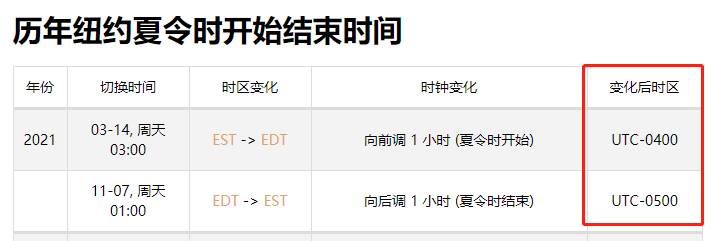LocalDateTime、OffsetDateTime、ZonedDateTime互转,这一篇绝对喂饱你

前言
你好,我是A哥(YourBatman)。
在JSR 310日期时间体系了,一共有三个API可用于表示日期时间:
- LocalDateTime:本地日期时间
- OffsetDateTime:带偏移量的日期时间
- ZonedDateTime:带时区的日期时间
也许平时开发中你只用到过LocalDateTime这个API,那是极好的,但是不能止步于此,否则就图样图森破了。
随着场景的多样性变化,咱们开发者接触到OffsetDateTime/ZonedDateTime的概率越来越大,但凡和国际化产生上关系的大概率都会用得到它们。本文依然站在实用的角度,辅以具体代码示例,介绍它三。
本文提纲

版本约定
- JDK:8
正文
下面这张图是一个完整的日期时间,拆解各个部分的含义,一目了然(建议收藏此图):

因为LocalDate、LocalTime等理解起来比较简单,就不用再花笔墨介绍了,重点放在LocalDateTime、OffsetDateTime、ZonedDateTime它三身上。
什么是LocalDateTime?

ISO-8601日历系统中不带时区的日期时间。
说明:ISO-8601日系统是现今世界上绝大部分国家/地区使用的,这就是我们国人所说的公历,有闰年的特性
LocalDateTime是一个不可变的日期-时间对象,它表示一个日期时间,通常被视为年-月-日-小时-分钟-秒。还可以访问其他日期和时间字段,如day-of-year、day-of-week和week-of-year等等,它的精度能达纳秒级别。
该类不存储时区,所以适合日期的描述,比如用于生日、deadline等等。但是请记住,如果没有偏移量/时区等附加信息,一个时间是不能表示时间线上的某一时刻的。
代码示例
最大/最小值:
@Test
public void test1() {
LocalDateTime min = LocalDateTime.MIN;
LocalDateTime max = LocalDateTime.MAX;
System.out.println("LocalDateTime最小值:" + min);
System.out.println("LocalDateTime最大值:" + max);
System.out.println(min.getYear() + "-" + min.getMonthValue() + "-" + min.getDayOfMonth());
System.out.println(max.getYear() + "-" + max.getMonthValue() + "-" + max.getDayOfMonth());
}
输出:
LocalDateTime最小值:-999999999-01-01T00:00
LocalDateTime最大值:+999999999-12-31T23:59:59.999999999
-999999999-1-1
999999999-12-31
构造:
@Test
public void test2() {
System.out.println("当前时区的本地时间:" + LocalDateTime.now());
System.out.println("当前时区的本地时间:" + LocalDateTime.of(LocalDate.now(), LocalTime.now()));
System.out.println("纽约时区的本地时间:" + LocalDateTime.now(ZoneId.of("America/New_York")));
}
输出:
当前时区的本地时间:2021-01-17T17:00:41.446
当前时区的本地时间:2021-01-17T17:00:41.447
纽约时区的本地时间:2021-01-17T04:00:41.450
注意,最后一个构造传入了ZoneId,并不是说LocalDateTime和时区有关了,而是告诉说这个Local指的是纽约,细品这句话。
计算:
@Test
public void test3() {
LocalDateTime now = LocalDateTime.now(ZoneId.systemDefault());
System.out.println("计算前:" + now);
// 加3天
LocalDateTime after = now.plusDays(3);
// 减4个小时
after = after.plusHours(-3); // 效果同now.minusDays(3);
System.out.println("计算后:" + after);
// 计算时间差
Period period = Period.between(now.toLocalDate(), after.toLocalDate());
System.out.println("相差天数:" + period.getDays());
Duration duration = Duration.between(now.toLocalTime(), after.toLocalTime());
System.out.println("相差小时数:" + duration.toHours());
}
输出:
计算前:2021-01-17T17:10:15.381
计算后:2021-01-20T14:10:15.381
相差天数:3
相差小时数:-3
格式化:
@Test
public void test4() {
LocalDateTime now = LocalDateTime.now(ZoneId.systemDefault());
// System.out.println("格式化输出:" + DateTimeFormatter.ISO_LOCAL_DATE_TIME.format(now));
System.out.println("格式化输出(本地化输出,中文环境):" + DateTimeFormatter.ofLocalizedDateTime(FormatStyle.SHORT, FormatStyle.SHORT).format(now));
String dateTimeStrParam = "2021-01-17 18:00:00";
System.out.println("解析后输出:" + LocalDateTime.parse(dateTimeStrParam, DateTimeFormatter.ofPattern("yyyy-MM-dd HH:mm:ss", Locale.US)));
}
输出:
格式化输出(本地化输出,中文环境):21-1-17 下午5:15
解析后输出:2021-01-17T18:00
什么是OffsetDateTime?

ISO-8601日历系统中与UTC偏移量有关的日期时间。OffsetDateTime是一个带有偏移量的日期时间类型。存储有精确到纳秒的日期时间,以及偏移量。可以简单理解为 OffsetDateTime = LocalDateTime + ZoneOffset。

OffsetDateTime、ZonedDateTime和Instant它们三都能在时间线上以纳秒精度存储一个瞬间(请注意:LocalDateTime是不行的),也可理解我某个时刻。OffsetDateTime和Instant可用于模型的字段类型,因为它们都表示瞬间值并且还不可变,所以适合网络传输或者数据库持久化。
ZonedDateTime不适合网络传输/持久化,因为即使同一个ZoneId时区,不同地方获取到瞬时值也有可能不一样
代码示例
最大/最小值:
@Test
public void test5() {
OffsetDateTime min = OffsetDateTime.MIN;
OffsetDateTime max = OffsetDateTime.MAX;
System.out.println("OffsetDateTime最小值:" + min);
System.out.println("OffsetDateTime最大值:" + max);
System.out.println(min.getOffset() + ":" + min.getYear() + "-" + min.getMonthValue() + "-" + min.getDayOfMonth());
System.out.println(max.getOffset() + ":" + max.getYear() + "-" + max.getMonthValue() + "-" + max.getDayOfMonth());
}
输出:
OffsetDateTime最小值:-999999999-01-01T00:00+18:00
OffsetDateTime最大值:+999999999-12-31T23:59:59.999999999-18:00
+18:00:-999999999-1-1
-18:00:999999999-12-31
偏移量的最大值是+18,最小值是-18,这是由ZoneOffset内部的限制决定的。
构造:
@Test
public void test6() {
System.out.println("当前位置偏移量的本地时间:" + OffsetDateTime.now());
System.out.println("偏移量-4(纽约)的本地时间::" + OffsetDateTime.of(LocalDateTime.now(), ZoneOffset.of("-4")));
System.out.println("纽约时区的本地时间:" + OffsetDateTime.now(ZoneId.of("America/New_York")));
}
输出:
当前位置偏移量的本地时间:2021-01-17T19:02:06.328+08:00
偏移量-4(纽约)的本地时间::2021-01-17T19:02:06.329-04:00
纽约时区的本地时间:2021-01-17T06:02:06.330-05:00
计算:
略
格式化:
@Test
public void test7() {
OffsetDateTime now = OffsetDateTime.now(ZoneId.systemDefault());
System.out.println("格式化输出(本地化输出,中文环境):" + DateTimeFormatter.ofLocalizedDateTime(FormatStyle.SHORT, FormatStyle.SHORT).format(now));
String dateTimeStrParam = "2021-01-17T18:00:00+07:00";
System.out.println("解析后输出:" + OffsetDateTime.parse(dateTimeStrParam));
}
输出:
格式化输出(本地化输出,中文环境):21-1-17 下午7:06
解析后输出:2021-01-17T18:00+07:00
转换:
LocalDateTime -> OffsetDateTime
@Test
public void test8() {
LocalDateTime localDateTime = LocalDateTime.of(2021, 01, 17, 18, 00, 00);
System.out.println("当前时区(北京)时间为:" + localDateTime);
// 转换为偏移量为 -4的OffsetDateTime时间
// 1、-4地方的晚上18点
System.out.println("-4偏移量地方的晚上18点:" + OffsetDateTime.of(localDateTime, ZoneOffset.ofHours(-4)));
System.out.println("-4偏移量地方的晚上18点(方式二):" + localDateTime.atOffset(ZoneOffset.ofHours(-4)));
// 2、北京时间晚上18:00 对应的-4地方的时间点
System.out.println("当前地区对应的-4地方的时间:" + OffsetDateTime.ofInstant(localDateTime.toInstant(ZoneOffset.ofHours(8)), ZoneOffset.ofHours(-4)));
}
输出:
当前时区(北京)时间为:2021-01-17T18:00
-4偏移量地方的晚上18点:2021-01-17T18:00-04:00
-4偏移量地方的晚上18点(方式二):2021-01-17T18:00-04:00
当前地区对应的-4地方的时间:2021-01-17T06:00-04:00
通过此例值得注意的是:LocalDateTime#atOffset()/atZone()只是增加了偏移量/时区,本地时间是并没有改变的。若想实现本地时间到其它偏移量的对应的时间只能通过其ofInstant()系列构造方法。
OffsetDateTime -> LocalDateTime
@Test
public void test81() {
OffsetDateTime offsetDateTime = OffsetDateTime.of(LocalDateTime.now(), ZoneOffset.ofHours(-4));
System.out.println("-4偏移量时间为:" + offsetDateTime);
// 转为LocalDateTime 注意:时间还是未变的哦
System.out.println("LocalDateTime的表示形式:" + offsetDateTime.toLocalDateTime());
}
输出:
-4偏移量时间为:2021-01-17T19:33:28.139-04:00
LocalDateTime的表示形式:2021-01-17T19:33:28.139
什么是ZonedDateTime?

ISO-8601国际标准日历系统中带有时区的日期时间。它存储所有的日期和时间字段,精度为纳秒,以及一个时区,带有用于处理不明确的本地日期时间的时区偏移量。
这个API可以处理从LocalDateTime -> Instant -> ZonedDateTime的转换,其中用zone时区来表示偏移量(并非直接用offset哦)。两个时间点之间的转换会涉及到使用从ZoneId访问的规则计算偏移量(换句话说:偏移量并非写死而是根据规则计算出来的)。
获取瞬间的偏移量很简单,因为每个瞬间只有一个有效的偏移量。但是,获取本地日期时间的偏移量并不简单。存在这三种情况:
- 正常情况:有一个有效的偏移量。对于一年中的绝大多数时间,适用正常情况,即本地日期时间只有一个有效的偏移量
- 时间间隙情况:没有有效偏移量。这是由于夏令时开始时从“冬季”改为“夏季”而导致时钟向前拨的时候。在间隙中,没有有效偏移量
- 重叠情况:有两个有效偏移量。这是由于秋季夏令时从“夏季”到“冬季”的变化,时钟会向后拨。在重叠部分中,有两个有效偏移量
这三种情况如果要自己处理,估计头都大了。这就是使用JSR 310的优势,ZonedDateTime全帮你搞定,让你使用无忧。
ZonedDateTime可简单认为是LocalDateTime和ZoneId的组合。而ZoneOffset是其内置的动态计算出来的一个次要信息,以确保输出一个瞬时值而存在,毕竟在某个瞬间偏移量ZoneOffset肯定是确定的。ZonedDateTime也可以理解为保存的状态相当于三个独立的对象:LocalDateTime、ZoneId和ZoneOffset。某个瞬间 = LocalDateTime + ZoneOffset。ZoneId确定了偏移量如何改变的规则。所以偏移量我们并不能自由设置(不提供set方法,构造时也不行),因为它由ZoneId来控制的。

代码示例
构造:
@Test
public void test9() {
System.out.println("当前位置偏移量的本地时间:" + ZonedDateTime.now());
System.out.println("纽约时区的本地时间:" + ZonedDateTime.of(LocalDateTime.now(), ZoneId.of("America/New_York")));
System.out.println("北京实现对应的纽约时区的本地时间:" + ZonedDateTime.now(ZoneId.of("America/New_York")));
}
输出:
当前位置偏移量的本地时间:2021-01-17T19:25:10.520+08:00[Asia/Shanghai]
纽约时区的本地时间:2021-01-17T19:25:10.521-05:00[America/New_York]
北京实现对应的纽约时区的本地时间:2021-01-17T06:25:10.528-05:00[America/New_York]
计算:
略
格式化:
略
转换:
LocalDateTime -> ZonedDateTime
@Test
public void test10() {
LocalDateTime localDateTime = LocalDateTime.of(2021, 01, 17, 18, 00, 00);
System.out.println("当前时区(北京)时间为:" + localDateTime);
// 转换为偏移量为 -4的OffsetDateTime时间
// 1、-4地方的晚上18点
System.out.println("纽约时区晚上18点:" + ZonedDateTime.of(localDateTime, ZoneId.of("America/New_York")));
System.out.println("纽约时区晚上18点(方式二):" + localDateTime.atZone(ZoneId.of("America/New_York")));
// 2、北京时间晚上18:00 对应的-4地方的时间点
System.out.println("北京地区此时间对应的纽约的时间:" + ZonedDateTime.ofInstant(localDateTime.toInstant(ZoneOffset.ofHours(8)), ZoneOffset.ofHours(-4)));
System.out.println("北京地区此时间对应的纽约的时间:" + ZonedDateTime.ofInstant(localDateTime, ZoneOffset.ofHours(8), ZoneOffset.ofHours(-4)));
}
输出:
当前时区(北京)时间为:2021-01-17T18:00
纽约时区晚上18点:2021-01-17T18:00-05:00[America/New_York]
纽约时区晚上18点(方式二):2021-01-17T18:00-05:00[America/New_York]
北京地区此时间对应的纽约的时间:2021-01-17T06:00-04:00
北京地区此时间对应的纽约的时间:2021-01-17T06:00-04:00
OffsetDateTime -> ZonedDateTime
@Test
public void test101() {
OffsetDateTime offsetDateTime = OffsetDateTime.of(LocalDateTime.now(), ZoneOffset.ofHours(-4));
System.out.println("-4偏移量时间为:" + offsetDateTime);
// 转换为ZonedDateTime的表示形式
System.out.println("ZonedDateTime的表示形式:" + offsetDateTime.toZonedDateTime());
System.out.println("ZonedDateTime的表示形式:" + offsetDateTime.atZoneSameInstant(ZoneId.of("America/New_York")));
System.out.println("ZonedDateTime的表示形式:" + offsetDateTime.atZoneSimilarLocal(ZoneId.of("America/New_York")));
}
-4偏移量时间为:2021-01-17T19:43:28.320-04:00
ZonedDateTime的表示形式:2021-01-17T19:43:28.320-04:00
ZonedDateTime的表示形式:2021-01-17T18:43:28.320-05:00[America/New_York]
ZonedDateTime的表示形式:2021-01-17T19:43:28.320-05:00[America/New_York]
本例有值得关注的点:
atZoneSameInstant():将此日期时间与时区结合起来创建ZonedDateTime,以确保结果具有相同的Instant- 所有偏移量-4 -> -5,时间点也从19 -> 18,确保了Instant保持一致嘛
atZoneSimilarLocal:将此日期时间与时区结合起来创建ZonedDateTime,以确保结果具有相同的本地时间- 所以直接效果和toLocalDateTime()是一样的,但是它会尽可能的保留偏移量(所以你看-4变为了-5,保持了真实的偏移量)
我这里贴出纽约2021年的夏令时时间区间:

也就是说在2021.03.14 - 2021.11.07期间,纽约的偏移量是-4,其余时候是-5。那么再看这个例子(我把时间改为5月5号,也就是处于夏令营期间):
@Test
public void test101() {
OffsetDateTime offsetDateTime = OffsetDateTime.of(LocalDateTime.of(2021, 05, 05, 18, 00, 00), ZoneOffset.ofHours(-4));
System.out.println("-4偏移量时间为:" + offsetDateTime);
// 转换为ZonedDateTime的表示形式
System.out.println("ZonedDateTime的表示形式:" + offsetDateTime.toZonedDateTime());
System.out.println("ZonedDateTime的表示形式:" + offsetDateTime.atZoneSameInstant(ZoneId.of("America/New_York")));
System.out.println("ZonedDateTime的表示形式:" + offsetDateTime.atZoneSimilarLocal(ZoneId.of("America/New_York")));
}
输出:
-4偏移量时间为:2021-05-05T18:00-04:00
ZonedDateTime的表示形式:2021-05-05T18:00-04:00
ZonedDateTime的表示形式:2021-05-05T18:00-04:00[America/New_York]
ZonedDateTime的表示形式:2021-05-05T18:00-04:00[America/New_York]
看到了吧,偏移量变为了-4。感受到夏令时的“威力”了吧。
OffsetDateTime和ZonedDateTime的区别
LocalDateTime、OffsetDateTime、ZonedDateTime这三个哥们,LocalDateTime好理解,一般都没有异议。但是很多同学对OffsetDateTime和ZonedDateTime傻傻分不清,这里说说它俩的区别。
- OffsetDateTime = LocalDateTime + 偏移量ZoneOffset;ZonedDateTime = LocalDateTime + 时区ZoneId
- OffsetDateTime可以随意设置偏移值,但ZonedDateTime无法自由设置偏移值,因为此值是由时区ZoneId控制的
- OffsetDateTime无法支持夏令时等规则,但ZonedDateTime可以很好的处理夏令时调整
- OffsetDateTime得益于不变性一般用于数据库存储、网络通信;而ZonedDateTime得益于其时区特性,一般在指定时区里显示时间非常方便,无需认为干预规则
- OffsetDateTime代表一个瞬时值,而ZonedDateTime的值是不稳定的,需要在某个瞬时根据当时的规则计算出来偏移量从而确定实际值
总的来说,OffsetDateTime和ZonedDateTime的区别主要在于ZoneOffset和ZoneId的区别。如果你只是用来传递数据,请使用OffsetDateTime,若你想在特定时区里做时间显示那么请务必使用ZonedDateTime。
总结
本着拒绝浅尝辄止的态度,深度剖析了很多同学可能不太熟悉的OffsetDateTime、ZonedDateTime两个API。总而言之,想要真正掌握日期时间体系(不限于Java语言,而是所有语言,甚至日常生活),对时区、偏移量的了解是绕不过去的砍,这块知识有所欠缺的朋友可往前翻翻补补课。
最后在使用它们三的过程中,有两个提醒给你:
- 所有日期/时间都是不可变的类型,所以若需要比较的话,请不要使用==,而是用equals()方法。
2、任何时候,构造一个日期时间(包括它们三)请永远务必显示的指定时区,哪怕是默认时区。这么做的目的就是明确代码的意图,消除语义上的不确定性。比如若没指定时区,那到底是写代码的人欠考虑了呢,还是就是想用默认时区呢?总之显示指定绝大部分情况下比隐式“指定”语义上好得多。
本文思考题
看完了不一定懂,看懂了不一定会。来,文末3个思考题帮你复盘:
- 如何用LocalDateTime描述美国纽约本地时间?
- OffsetDateTime和ZonedDateTime你到底该使用谁?
- 一个人的生日应该用什么Java类型存储呢?
推荐阅读
GMT UTC CST ISO 夏令时 时间戳,都是些什么鬼?
关注我
分享、成长,拒绝浅尝辄止。关注【BAT的乌托邦】回复关键字专栏有Spring技术栈、中间件等小而美的纯原创专栏。本文已被 https://www.yourbatman.cn 收录。
本文所属专栏:JDK日期时间,公号后台回复专栏名即可获取全部内容。
A哥(YourBatman):Spring Framework/Boot开源贡献者,Java架构师。非常注重基本功修养,相信底层基础决定上层建筑,坚实基础才能焕发程序员更强生命力。文章特点为以小而美专栏形式重构知识体系,抽丝剥茧,致力于做人人能看懂的最好的专栏系列。可加我好友(fsx1056342982)共勉哦!

System.out.println("点个赞吧!");
print_r('关注【BAT的乌托邦】!');
var_dump('点个赞吧!');
NSLog(@"关注【BAT的乌托邦】!");
console.log("点个赞吧!");
print("关注【BAT的乌托邦】!");
printf("点个赞吧!");
cout << "关注【BAT的乌托邦】!" << endl;
Console.WriteLine("点个赞吧!");
fmt.Println("关注【BAT的乌托邦】!");
Response.Write("点个赞吧!");
alert("关注【BAT的乌托邦】!");
echo("点个赞吧!");
LocalDateTime、OffsetDateTime、ZonedDateTime互转,这一篇绝对喂饱你的更多相关文章
- 时间戳和LocalDateTime和Date互转和格式化
一 前言 续上篇java8在日常开发中使用LocalDate和LocalTime[https://blog.csdn.net/youku1327/article/details/102771936]中 ...
- Java8 LocalDateTime获取时间戳(毫秒/秒)、LocalDateTime与String互转、Date与LocalDateTime互转
本文目前提供:LocalDateTime获取时间戳(毫秒/秒).LocalDateTime与String互转.Date与LocalDateTime互转 文中都使用的时区都是东8区,也就是北京时间.这是 ...
- LocalDateTime与字符串互转/Date互转/LocalDate互转/指定日期/时间比较
Java 8中表示日期和时间的类有多个,主要的有: Instant:表示时刻,不直接对应年月日信息,需要通过时区转换 LocalDateTime: 表示与时区无关的日期和时间信息,不直接对应时刻,需要 ...
- 互斥体与互锁 <第五篇>
互斥体实现了“互相排斥”(mutual exclusion)同步的简单形式(所以名为互斥体(mutex)).互斥体禁止多个线程同时进入受保护的代码“临界区”.因此,在任意时刻,只有一个线程被允许进入这 ...
- 转载 互斥体与互锁 <第五篇>
互斥体实现了“互相排斥”(mutual exclusion)同步的简单形式(所以名为互斥体(mutex)).互斥体禁止多个线程同时进入受保护的代码“临界区”.因此,在任意时刻,只有一个线程被允许进入这 ...
- Java日期时间API系列19-----Jdk8中java.time包中的新的日期时间API类,ZonedDateTime与ZoneId和LocalDateTime的关系,ZonedDateTime格式化和时区转换等。
通过Java日期时间API系列6-----Jdk8中java.time包中的新的日期时间API类中时间范围示意图:可以很清晰的看出ZonedDateTime相当于LocalDateTime+ZoneI ...
- java 8时间使用LocalDateTime,ZonedDateTime,LocalDate
前言 java 8的时间已经能够满足日常的使用,也方便理解.joda-time作为一个有优秀的时间组件也不得不告知使用者在java 8以后使用自带的时间 LocalDateTime以及ZonedDat ...
- java 8 LocalDateTime 20 例
http://www.importnew.com/15637.html 伴随lambda表达式.streams以及一系列小优化,Java 8 推出了全新的日期时间API,在教程中我们将通过一些简单的实 ...
- Java8 ,LocalDate,LocalDateTime处理日期和时间工具类,
Java8 ,LocalDate,LocalDateTime处理日期和时间工具类 1.获取今天的日期 2.在Java 8 中获取年.月.日信息 3.在Java 8 中处理特定日期 4.在Java 8 ...
随机推荐
- Spring Cloud Alibaba基础教程-Nacos(一)
2019快结束,也有很久没写博客了,今天我们来谈谈Nacos,如果对您有帮助,麻烦左上角点个关注 ,谢谢 ! 嘻嘻 今天先写第一篇 文章目录 为什么要使用Nacos Eureka 闭源 Nacos的优 ...
- Angular入门,开发环境搭建,使用Angular CLI创建你的第一个Angular项目
前言: 最近一直在使用阿里的NG-ZORRO(Angular组件库)开发公司后端的管理系统,写了一段时间的Angular以后发现对于我们.NET后端开发而言真是非常的友善.因此这篇文章主要是对这段时间 ...
- MySQL高可用(二)主备延时如何解决?
从上篇文章我们知道主备同步是依赖于 binlog,主库负责生产 binlog,备库负责消费 binlog,从而实现主备同步. 今天我们来学习一下主备同步里的一个重点的问题:主备延时. 主备延时,简单来 ...
- django.template.exceptions.TemplateSyntaxError: 'static' is not a registered tag library. Must be one of:
在访问web页面时报错,详细日志如下: django.template.exceptions.TemplateSyntaxError: 'staticfiles' is not a registere ...
- 精尽Spring MVC源码分析 - ViewResolver 组件
该系列文档是本人在学习 Spring MVC 的源码过程中总结下来的,可能对读者不太友好,请结合我的源码注释 Spring MVC 源码分析 GitHub 地址 进行阅读 Spring 版本:5.2. ...
- .net core 3.1 过滤器(Filter) 与中间件与AOP面向切面 与拦截器及其应用
Filter(过滤器) 总共有五种,Authorization Filter,Resource Filter,Exception Filter,Action Filter,Result Filter ...
- python初学者-商品折扣问题
x = int(input("x=")) if x < 1600 : #如果x小于1600,y等于0 y = 0 #没有折扣 print("应付款:",x ...
- Java学习日报7.30
package dog;import java.util.*;public class Dog { private String dogName; private String dogColor; p ...
- 【wp】2020XCTF_逆向
前几天的XCTF最后一场终于打完了,三场比赛下来对逆向部分的大概感觉是从第一场的啥都不会做(一道lua+一道apk)到后来的终于能有参与度,至少后两场的题目都是pc逆向,虽然特殊架构但好歹能做(tcl ...
- 5.从零开始创建一个QT窗口按钮
如何创建一个QT项目 如何创建一个QT项目 1.创建新项目 2.配置选择 3.增加按钮 4.按钮和窗体的大小标签图标设置 5.信号与槽 6.自定义信号与槽 代码 1.创建新项目 点击文件->新建 ...
